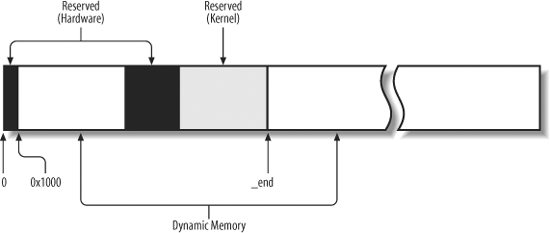Page Frame Management
We saw in the section "Paging in Hardware" in Chapter 2 how the Intel Pentium processor can use two different page frame sizes: 4 KB and 4 MB (or 2 MB if PAE is enabled—see the section "The Physical Address Extension (PAE) Paging Mechanism" in Chapter 2). Linux adopts the smaller 4 KB page frame size as the standard memory allocation unit. This makes things simpler for two reasons:
The Page Fault exceptions issued by the paging circuitry are easily interpreted. Either the page requested exists but the process is not allowed to address it, or the page does not exist. In the second case, the memory allocator must find a free 4 KB page frame and assign it to the process.
Although both 4 KB and 4 MB are multiples of all disk block sizes, transfers of data between main memory and disks are in most cases more efficient when the smaller size is used.

Figure 8-1. Dynamic memory
Page Descriptors
The kernel must keep track of the current status of each page frame. For instance, it must be able to distinguish the page frames that are used to contain pages that belong to processes from those that contain kernel code or kernel data structures. Similarly, it must be able to determine whether a page frame in dynamic memory is free. A page frame in dynamic memory is free if it does not contain any useful data. It is not free when the page frame contains data of a User Mode process, ...
Get Understanding the Linux Kernel, 3rd Edition now with the O’Reilly learning platform.
O’Reilly members experience books, live events, courses curated by job role, and more from O’Reilly and nearly 200 top publishers.

